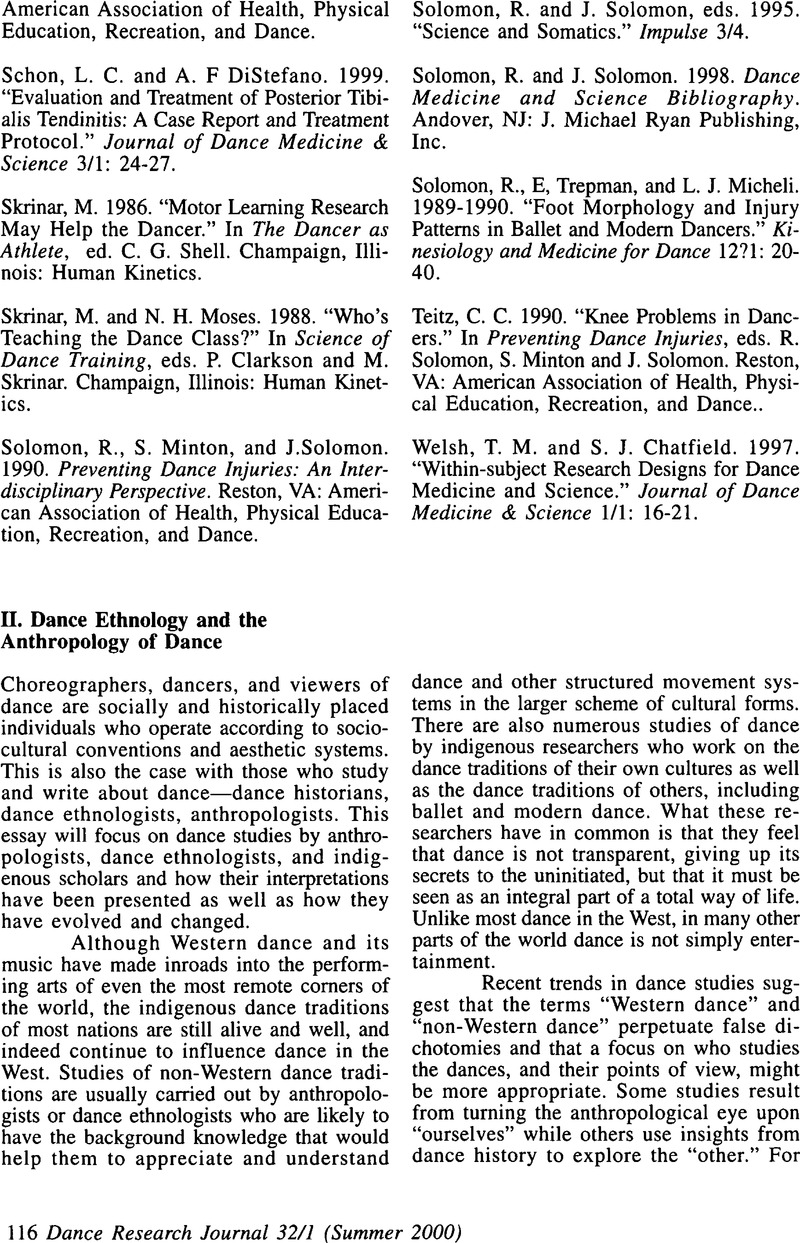Crossref Citations
This article has been cited by the following publications. This list is generated based on data provided by Crossref.
Dils, Ann
and
Crosby, Jill Flanders
2001.
Dialogue in Dance Studies Research.
Dance Research Journal,
Vol. 33,
Issue. 1,
p.
62.
Rowe, Nicholas
2008.
Dance education in the Occupied Palestinian Territories: hegemony, counter‐hegemony and anti‐hegemony.
Research in Dance Education,
Vol. 9,
Issue. 1,
p.
3.
Hermkens, Anna-Karina
2008.
Rejoinder to Drid Williams' Discussion.
Visual Anthropology,
Vol. 21,
Issue. 2,
p.
156.
Rowe, Nicholas
2009.
Post-Salvagism: Choreography and Its Discontents in the Occupied Palestinian Territories.
Dance Research Journal,
Vol. 41,
Issue. 1,
p.
45.
Atencio, Matthew
and
Wright, Jan
2009.
‘Ballet it’s too whitey’: discursive hierarchies of high school dance spaces and the constitution of embodied feminine subjectivities.
Gender and Education,
Vol. 21,
Issue. 1,
p.
31.
Rowe, N.
2010.
Movement Politics: Dance Criticism in the Occupied Palestinian Territories.
Forum for Modern Language Studies,
Vol. 46,
Issue. 4,
p.
441.
Khoury, Krystel
Martin, Rosemary
and
Rowe, Nicholas
2013.
Bursting bubbles between sand and sea: teaching dance on the edge of the Mediterranean.
Research in Dance Education,
Vol. 14,
Issue. 3,
p.
187.
Gibson, N Jade
2013.
Moving bodies, shifting selves: integration and incorporation through ‘jazzing’ and ‘salsa’ dance in Cape Town.
Journal of the Musical Arts in Africa,
Vol. 10,
Issue. 1,
p.
33.
Kiss, Dóra
2014.
Interpréter le « Menuet performd’ by Mrs. Santlow ».
Recherches en danse,
Gonye, Jairos
and
Manase, Irikidzayi
2015.
Debunking the Zimbabwean Myth of Jikinya Dance in Ndhlala’s Jikinya and Zimunya’s “Jikinya” (Dancer) and “Jikinya” (An African Passion).
Journal of Black Studies,
Vol. 46,
Issue. 2,
p.
123.
Eli, Karin
and
Kay, Rosie
2015.
Choreographing lived experience: dance, feelings and the storytelling body.
Medical Humanities,
Vol. 41,
Issue. 1,
p.
63.
Skinner, Jonathan
2016.
Walking the Falls: Dark tourism and the significance of movement on the political tour of West Belfast.
Tourist Studies,
Vol. 16,
Issue. 1,
p.
23.
De Rosa, Sinibaldo
2016.
Aspetti metodologici in uno studio etnografico sul semah degli Aleviti.
Recherches en danse,
Topić, Martina
2017.
Introduction.
Israel Affairs,
Vol. 23,
Issue. 6,
p.
995.
Rossolatos, George
2017.
What’s in a thang? Dancing to brand image with Miley Cyrus’ multimodal dance spectacle.
Arts and the Market,
Vol. 7,
Issue. 1,
p.
101.
ELISHA, OMRI
2018.
Dancing the Word:.
American Ethnologist,
Vol. 45,
Issue. 3,
p.
380.
Anjos, Rafael Kuffner dos
Ribeiro, Claudia
and
Fernandes, Carla
2018.
Three-Dimensional Visualization of Movement Qualities in Contemporary Dance.
p.
1.
Cuan, Catie
Pakrasi, Ishaan
and
LaViers, Amy
2018.
Social Robotics.
Vol. 11357,
Issue. ,
p.
503.
Senn, Olivier
Rose, Dawn
Bechtold, Toni
Kilchenmann, Lorenz
Hoesl, Florian
Jerjen, Rafael
Baldassarre, Antonio
and
Alessandri, Elena
2019.
Preliminaries to a Psychological Model of Musical Groove.
Frontiers in Psychology,
Vol. 10,
Issue. ,
Budano, Paola
2019.
The Addaura Cave: Dance and Rite in Mesolithic Sicily.
Open Archaeology,
Vol. 5,
Issue. 1,
p.
586.





